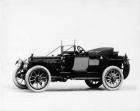|
Re: A question about a seal
|
||||
|---|---|---|---|---|
|
Home away from home

|
I am no mechanic but my friend and I changed my pinion seal on my 56 by just dropping the driveshaft. Had to use an impact wrench in short bursts to remove and install the nut. A hand wrench just spun everything. Hopefully a real mechanic will chime in to help.
Posted on: 2012/4/8 18:34
|
|||
|
||||
|
Re: A question about a seal
|
||||
|---|---|---|---|---|
|
Home away from home
|
IBUB,
I believe you are talking about replacing the pinion shaft seal. This is not a particularly difficult job, but extreme care must be taken to get the large nut re-installed to exactly were it was before removing. Note the position before removing and count, very carefully, the number of turns to remove the nut. Then screw the nut back on the very same number of turns to the exact position it was before removing. This is necessary to maintain the pre-load on the pinion bearings. Do it correctly and no problems; do it incorrectly, and you will be looking for a new differential. You do not need to drop the rear axle assembly to do this job. Good luck, and let us know how the job goes. I am no mechanic, but have read about doing this job on this site. (o[]o)
Posted on: 2012/4/9 12:41
|
|||
|
We move toward
And make happen What occupies our mind... (W. Scherer) |
||||
|
||||
|
Re: A question about a seal
|
||||
|---|---|---|---|---|
|
Forum Ambassador

|
Good instructions JW, unless you're fortunate to have a new crush sleeve available. There was one on eBay a few days ago.
Posted on: 2012/4/9 13:54
|
|||
|
||||
|
Re: A question about a seal
|
||||
|---|---|---|---|---|
|
Home away from home

|
Dear IBUB:
First make sure the unit is not over filled and then make sure the vent is not clogged. I would also do a measured consumption check over time because when cars aren't driven these seals often start leaking and if your car leaks a half pint per year you may want to do something more worthwhile. I have also seen the differential housing bolts loose which is remedied by careful tightening and a little RTV applied externally after careful cleaning. Replacing the seal is a standard in the car procedure, but there are different degrees of expertise that are applied. For example, in the flat rate chisel the skilled labor world they are not paid to do the job right so they don't. The parts are usually worn anyway so the oil stops leaking and somewhere down the road the rest of the car falls apart. The correct way to address the repair is to pull both axles and record the "Turning Torque To Rotate" using a special inch pounds torque wrench. Next a special bar is required to hold the flange so that a hand wrench can be used to loosen the nut (which is not to be reused, but can't be replaced so you are going to reuse it anyway). You can mark the nut with panit to give you an idea of how to get it back to where it was originally, but that is not really necessary. After the flange is removed you can replace the seal. As for assembly, the axle builders will tell you that impact wrenches will damage the unit. Period, end of story. Inside the unit is a collapsable spacer (unless you are working on a senior car which is different) that controls the amount of pinion bearing preload. When you reassemble the unit you want to get the nut back to where it was and then adjust the preload slightly to account for wear. So when you have the nut back to where you think was you should again check the Turning Torque To Rotate and if it is near to where it was initially tighten the nut further to increase it slightly (say 5 inch lbs). This may only require a half turn. But beware if the nut is overtightened the spacer will collapse and the pinion preload will be too high. Usually nobody wants to hear about the time it takes to follow this procedure so they get the impact treatment. Also, make sure to use Blue Threadlocker on that pinion nut. How's that?
Posted on: 2012/4/9 16:54
|
|||
|
||||








